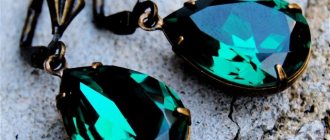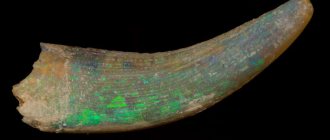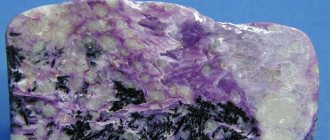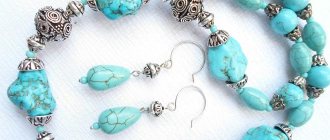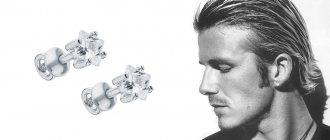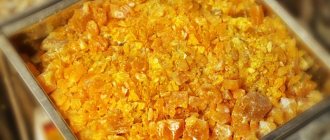How to properly care for opals and what is the best method? What is a doublet? What is a triplet? How to clean opal and what happens if it gets wet? All this is often of interest to potential and actual owners of opal jewelry.
To begin with, opals are minerals with low hardness. They differ from other stones by their iridescent tints and high degree of luminescence. Opals belong to precious stones. Some of the samples found are very expensive on the market.
Opal in the prior
We love opals dearly, so we want to talk about proper care for them. Following a few simple rules will allow you to enjoy the amazing beauty of these exquisite and unique gems for many years to come. Take just a few minutes to read this short guide, and if you have any additional questions, we're always here to answer them.
Doublet, triplet and solid opal
Caring for opals is not difficult. In fact, all you need is a responsible approach and sufficient knowledge. To decide on the method of care, you need to understand what type of opal you own.
Classification involves division into three main categories:
- Doublet. It consists of two layers - a plate of natural opal and a black backing to which it is attached. This design allows you to improve the color of the stone.
- Triplet. This type of opal is similar to a doublet, the only difference is that there is a third transparent layer of quartz or glass, which provides protection and helps create a perfect round shape.
- Solid opal. It is a polished and faceted natural opal without any auxiliary layers.
PRICE
At a time when Europe was inhabited only by dumb bearded men with stone axes, this precious mineral already bore its proud name and was valued above other gems. And in our time, buying opal means guaranteed to join the ranks of admirers of the exotic beauty of this stone.
Opals are mined on all continents, but each deposit produces its own type of gem. Minerologists distinguish at least ten varieties of this most beautiful of stones, and each type has its own subspecies.
Trying to buy the best quality gemstone, collectors are often faced with an unattainable goal - because every opal represents an incomprehensible perfection...
Price range USD: 130.00 – 550.00. Price range RUB: 4020.00 – 18205.00.
Caring for opal jewelry
Solid opals are quite fragile. They are equivalent in hardness to glass, which is about 6.5 on the Mohs scale. Therefore, to prevent the stone from being damaged, it is extremely important to treat it with care. Be sure to remove opal jewelry when there is a high risk of breaking or scratching it, for example, during gardening work, when rearranging furniture, etc.
In fact, the most valuable specimens contain 5-6% water. Consequently, they can crack if the air is too dry and there are sudden changes in temperature. Therefore, it is necessary to avoid such conditions during wearing and storage, for example, not being near boiling water or not keeping the opal in bank vaults where the humidity level is zero.
Many people believe that it is strictly contraindicated to wet solid opals, but this only applies to doublets and triplets. Solid opals are completely unaffected by moisture.
Caring for doublets and triplets differs compared to solid opals. This is due to the presence of several layers connected using a special glue. Prolonged exposure to water will eventually cause delamination and liquid penetration into the stone. As a result, the gem becomes cloudy and gray. But this does not mean at all that it will deteriorate if one day you forget to take off jewelry with such an opal while taking a shower or if you get caught in heavy rain. Negative consequences will appear only in case of prolonged exposure to water on a doublet or triplet.
HOW TO DISTINGUISH FROM A FAKE
More and more often, rare opals are being counterfeited by passing off colored glass as them. A few tips to distinguish natural stone from ordinary glass.
1. In bright sunlight, natural opal displays many colors, while artificial opal radiates only one color. The shine of natural stone is brighter and more intense than that of a fake.
2. The hardness of natural opal significantly exceeds the hardness of a synthetic fake.
3. Zonal coloring is more pronounced in natural stone.
4. A magnifying glass will help you distinguish a fake. Use it to carefully examine the stone: as a rule, a fake has obvious layers that are formed as a result of gluing glass and thin opal plates.
Opal cleaning
Solid opal requires extremely careful cleaning. Use a gentle detergent, warm water and a soft toothbrush or cloth. Avoid bleaches, chemicals and harsh cleaning mixtures. Doublets and triplets can be wiped with a damp, non-harsh material using a mild detergent, but should never be soaked or completely immersed in water.
Solid opal prepared for cutting
Never allow your opal jewelry to be ultrasonically cleaned. Intense vibrations can cause a solid opal to split and water to penetrate into doublets and triplets.
If your stone has lost its former shine or is scratched, contact a professional opal cutter. Small cracks and abrasions on the gem, which may appear after many years of wear, lead to a deterioration in the shine of its surface. Consequently, the stone loses its original shine and takes on a dull appearance. Professional polishing will give this opal new life. The technician will also check the mounting for damage and the reliability of the frame.
Special properties
After studying the stone, it became known that its body may contain up to 30% water. This is an incredible fact that cannot be attributed to any other type of mineral. This is what makes opal unique. Such a large percentage of liquid in stones is rare, but being in such a state, the mineral can no longer be called a stone; it becomes more of a gel. In other cases, the percentage of the water component does not exceed 10%, which is also quite significant for rocks.
These unique properties make opal special and at the same time fragile, susceptible to various environmental factors. Due to their porous structure, due to which they are able to absorb water and become a gel, other unwanted substances can also get into the opals. These gems actively absorb odors, fats, and dyes.
All this can have a detrimental effect on the quality of the stone, ruin its appearance and even split or crack. Therefore, caring for the mineral requires especially careful and careful care, depending not only on the type of stone itself, but also on many other aspects. Often the mineral is sold not in its entirety, but glued together or refined by painting or filling with resins.
Opal storage
You can store the opal in a convenient place, after placing it in a separate bag made of soft fabric, which will provide the required protection. But if we are talking about long-term storage, you need to put the stone on a piece of cotton wool moistened with a few drops of water, and then in a sealed plastic bag for safety. Water will not be able to absorb into the opal, since it is impenetrable, but it will prevent moisture loss in dry air conditions, for example, when there is zero humidity in a bank safe.
This is how opals are mined in mines
We hope you found this guide helpful. Take care of your opal and seek advice if you have any questions!
INTERESTING FACTS
Various peoples described precious opal in their legends:
- In Ancient Greece, it was believed that when Zeus cried with happiness, his tears, touching the ground, turned into wonderful opals.
- In Australia there is a belief that says that when the creator came down from heaven to look at his possessions, after each step he left an unusual stone that shimmered with all the colors of the rainbow.
- There is a legend in India that one day the goddess of the Rainbow, running away from annoying admirers, tripped over a stone and, falling, died, turning into a pile of beautiful opals.
- The largest white opal, weighing 26,350 carats, was found at the Jupiter placers in South Australia in July 1989. It was named Jupiter 5 and is now privately owned. The largest black opal of 1520 carats and measuring 121-80-15 mm was found on February 4, 1972 in Australia.
Talismans and amulets
Fire opal
From time immemorial, people have turned to opals for help. Depending on the color of the stones, talismans and amulets of different types were made from them:
- Black gems are needed by everyone who, due to their line of work, needs to concentrate and be always on the alert. But at the same time, black opals are contraindicated for adventurers, risky and gambling individuals, as it will be difficult for them to stop. Gold rings with a black stone are a favorite attribute of magicians, as they give the ability to view the probabilities of events and predict the future.
- White stones are assistants for people in social professions - teachers, volunteers, social service workers. They help to quickly establish contacts, find compromises and mutual understanding, and make people kinder and more compassionate towards the troubles of others. A white stone with bright opalescence, inserted into a gold ring or ring, is a personal talisman for doctors. If the “followers of Hippocrates” wear it on the index finger of their right hand, they will gain the ability to heal people.
- Fire opal will be useful for women to become more attractive and flirtatious, and for men to learn to look at things rationally and increase their authority.
- Blue varieties are effective money amulets. They contribute to the development of a person, the speedy achievement of his intended goals and attract cash flows to the owner.
- Pink stones are love talismans. They will be useful for single people to find a soul mate, and for married people to ignite a fading passion.
- Green gems are reliable amulets and personal healers.
Absolutely all opals inserted into a pendant or keychain made of silver are amulets against mental turmoil of any nature - worries, fears, bad thoughts, disappointments, grievances, painful memories, lack of faith in one’s own strengths and suicidal tendencies. And figurines from ignoble varieties will protect the house from misfortunes and evil people, and will also create a warm atmosphere in it.
The most finicky minerals
All stones are beautiful in their own way. Some of them require special cleaning to preserve their original beauty. The latter include minerals of organic origin. Inimitable pearls, amber, turquoise, mother-of-pearl and coral are demanding in terms of the composition of the cleanser . Cleaning these stones with a solution containing any chemicals simply means getting rid of them. For cleaning, only water at room temperature without any impurities, a soft brush or brush and cloth are suitable.
Pearls born in it love water very much. It is not only possible to wash it, but also necessary. Best in sea water. There is no such possibility - any water will do, the main thing is that it does not contain harmful impurities. After these manipulations, the stone will sparkle like new. Delicate turquoise stones do not like either water or sun. Amber, a former resin that has retained its properties, does not tolerate heat, which can even melt the stone. You only need to clean it in warm water or soap solution, and then wipe it dry with a soft piece of cloth. You cannot wash in the bathhouse or go to the sauna, as well as cook food, if you are wearing jewelry made of amber and coral. Stones become dull and lose their properties. Somehow it is not customary for our compatriots to periodically clean precious gems. Please, always be ready to clean gold, platinum and especially silver. But it's not right. It’s better to clean the stone one more time than to clean the silver; it definitely won’t deteriorate completely. And if this does happen to the stone, there is only one way out - replace it and subsequently follow all measures to preserve the beauty and quality of the mineral.
Colors and varieties
Opals are a huge group of different colors, intensity of brilliance, degree of transparency, hardness and the presence of mineral impurities.
Two main subgroups:
- Noble opals (precious stones) - have a beautiful color (milky white, yellowish, black, blue, yellow-red), they are always transparent or translucent.
- Ordinary opals (semi-precious stones) are colored in dull and dull tones or colorless, and can be transparent to varying degrees.
The most famous varieties are:
- Fire opals are transparent or translucent stones with a red-yellow color scheme. Some Mexican specimens show opalescence.
Fire opal
- Black opals - these include all varieties of dark tones, including dark brown and inky specimens.
Black opal
- Hydrophanes are porous stones that, when absorbing water, become transparent and display a play of colors.
Hydrophane water opal
- Boulders are a type of opal formed as a layer in the rock. The name translates as “boulder” or “cobblestone”.
Boulder opal
- Chrysopals (prasopals) are opaque specimens of an apple-green hue.
Chrysopal
- Wax opals have a waxy yellow color.
Wax opal
- Peruvian opals (blue Peruvian opals) - can have a blue, pink and bluish color, do not differ in color play, and are mined in Peru.
Blue Peruvian opal
- Girasoli are transparent stones, almost colorless, with a blue tint.
Opal Girasol
- Cacholongs (pearl opals) are a mixture of porcelain opal, quartz and chalcedony, opaque, milky white in color.
Cacholong
- Irisopals are a colorless or brownish type of opal mined in Mexico, characterized by a single-color tint.
Irisopal
- Wood opals - formed in the process of replacing wood with a mineral, can repeat the pattern of tree rings.
Wood opal
- Opal jasper samples - due to the high content of iron oxides, the stones are colored brown or red.
Opal Jasper
Cutting Features
The opal itself is quite thin, so it can be easily damaged during the cutting process. An opaque round/oval stone is often set into blind castes that squeeze it from all sides. The metal around the perimeter reliably protects the stone from loosening, as well as from cracks and chips when dropped. For additional protection, the opals are coated with a transparent synthetic resin. However, in the case of strong compression, microcracks may appear in the stone. The reliability and durability of such a frame directly depends on the professionalism of the craftsman.
A more delicate way is to secure the stone with small hooks or, in other words, prongs. In such a product, the stone is completely open, which makes it more vulnerable to external influences.
All natural stones are of different sizes and shapes, so an individual cut is selected for each one. The cut follows the natural shape of the stone.
Fire opals are often cut into diamonds. In other cases, the stones are cut into oval/round cabochons, which emphasize the original shape and color of the stone. Sometimes rings/earrings with large opal in gold are complemented with cubic zirconia or quartz to match the main shade of the mineral.
Frame
Opal is a stone of extraordinary beauty, so it needs a worthy presentation in decoration. This chameleon stone harmonizes with the bright shine of yellow/red metal and with the cold calm of white aurum and blackened silver. The dark background enhances the iridescent glow of the stone.
Warm-toned stones look best when set in gold, which is like a mirror, reflecting light and adding shine to the opal. But gems of cold emerald blue shades are best combined with silver or white gold.
Transparent opal risks getting lost in a white frame. In this case, a frame made of yellow aurum or silver with blackening will help him “play.”
Features of the physical characteristics of opal
There are two features that the opal owner must know about.
- This beautiful stone is much softer than most precious stones used in jewelry. Hardness on the Moss scale ranges from 5.5 to 6.5. Therefore, the mineral can be scratched and damaged very easily.
- The second important feature is that in terms of its physical properties it is no longer even a stone, but a kind of gel-like substance . This is due to the fact that opal contains up to thirty percent water, which it easily absorbs due to its porous structure.
Healing properties of opal stone
Opal earrings
Despite the signs and superstitions that associate the stone with misfortune, death and impermanence, the healing properties of opal were valued in ancient times. He was credited with the ability to heal heart ailments and protect against infection.
During plague epidemics, many wore rings with opal inserts, hoping for miraculous protection. Modern lithotherapists assure that opal will calm and balance the nervous system, prevent fainting, and relieve melancholy.
Alternative healing also suggests using the stone to treat the eyes. The gem will restore visual acuity if used correctly: massage the “third eye” area with it for five minutes.
The healing power of the stone is enhanced if you do not just apply it, but draw an imaginary cross over the sore area.
Blue opal (Peruvian) is endowed with great healing power. This is the best relaxing stone and is amazing for meditation. It is used to calm excessive emotionality, relieve mental anxiety, and restore healthy sleep.


